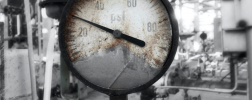Liquid-filled gauges surpass dry gauges for two main reasons: performance and extended service life. Pressure gauges that are filled with a liquid, usually glycerin or silicone oil, perform better in less-than-ideal conditions. They are also more economical in the long …
All posts by Hardy Orzikowski
Dampened Movement Industrial Instrumentation: Pressure Gauges and Bimetal Thermometers
Hardy Orzikowski | Know-how, Pressure, TemperatureIn applications with vibration and pulsation, either a liquid-filled case or dampened movement industrial instrumentation will minimize pointer oscillation. The better choice depends on the application and, to a certain extent, a user’s risk tolerance for leaks. …
Low Pressure Gauges: For Very Low and Vacuum Pressure Measurements
Hardy Orzikowski | Know-how, PressureTo accurately measure pressure below 10 psi (690 mbar), mechanical gauges use a capsule element. Capsule gauges are found in applications that operate in a vacuum or pressures as low as 1" water column. In most Bourdon tube pressure gauges , the range …
Introduction to Differential Pressure Measurement
Hardy Orzikowski | Know-how, PressureBy measuring differential pressure, users are able to easily and accurately monitor filter conditions, liquid levels in closed tanks, liquid flow rates inside a pipe, and even the output torque of hydraulic motors. There are three methods of measuring pressure. The …
8 Common Reasons For Pressure Gauge Failure
Hardy Orzikowski | Know-how, PressurePressure gauge failure can be attributed to one or more of these eight reasons: mechanical vibration, pulsation, extreme temperature, pressure spikes, overpressure, corrosion, clogging, and mishandling/abuse. Pressure gauges are an integral part of an …






